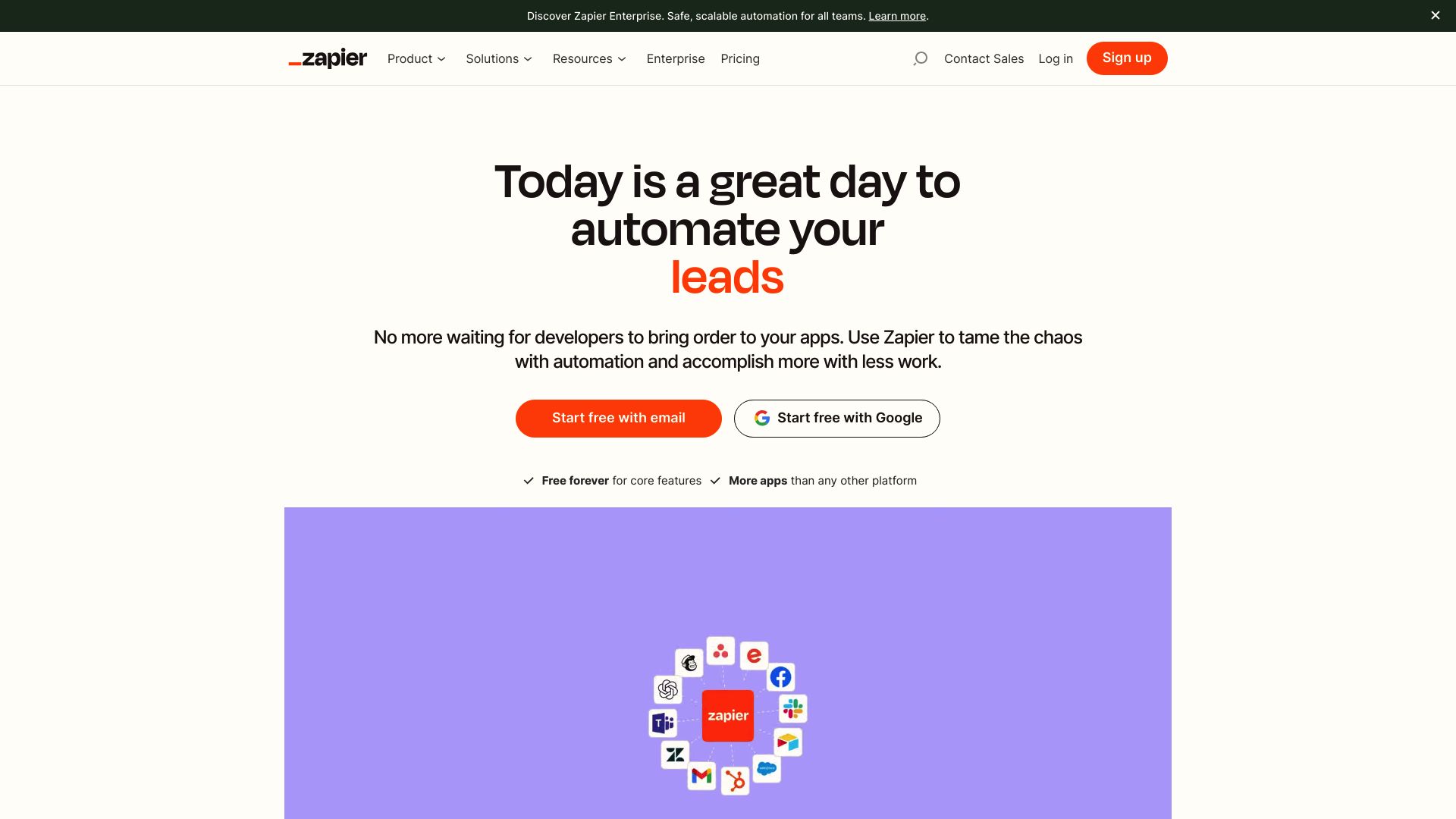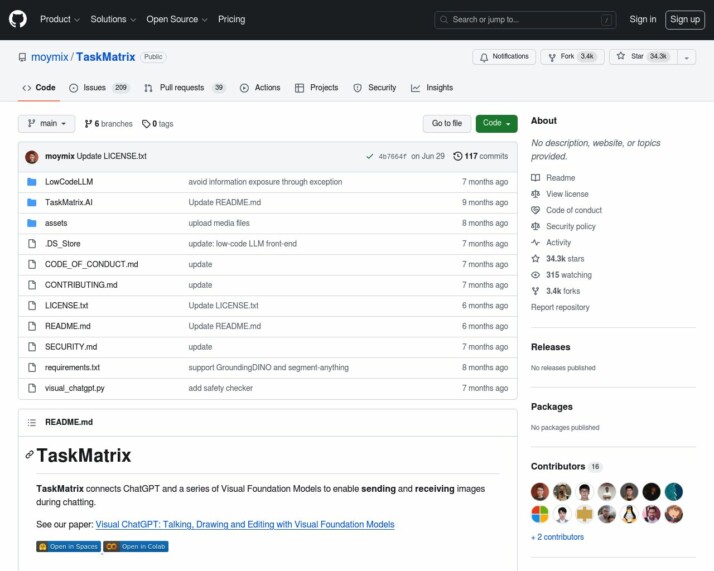Zapier vs. TaskMatrix: AI-Powered Automation Compared
AI-driven automation platforms are transforming how businesses streamline workflows and enhance productivity. This comprehensive review compares three leading solutions: Zapier vs. TaskMatrix, and SmythOS. We’ll explore their unique approaches to app integration, AI capabilities, and user-friendly features.
Whether you’re a developer seeking advanced AI tools, a business leader looking for scalable solutions, or a non-technical user in need of accessible automation, this comparison will help you navigate the evolving landscape of AI-powered platforms. Discover how each solution tackles workflow automation, AI integration, and customization to find the best fit for your organization’s needs.
Zapier Overview
Zapier empowers users to connect and automate workflows across thousands of apps without coding. The platform’s visual builder enables quick creation of multi-step processes called Zaps, streamlining repetitive tasks for businesses of all sizes.


Zapier’s strength lies in its vast ecosystem of over 6,000 integrated apps, allowing users to automate workflows across popular business tools like G Suite, Slack, and Salesforce. The platform caters to both non-technical users through its intuitive interface and developers who can leverage JavaScript for custom logic.
Zapier’s strength lies in its vast ecosystem of over 6,000 integrated apps, allowing users to automate workflows across popular business tools like G Suite, Slack, and Salesforce.
While Zapier excels at app integration, it lacks AI agent capabilities and advanced features like autonomous decision-making or natural language processing. The platform focuses on rule-based automation rather than intelligent, context-aware agents.
Zapier’s scalability and enterprise features, including team collaboration and robust security measures, make it suitable for businesses of varying sizes. However, users seeking more advanced AI functionalities or conversational interfaces may find the platform’s capabilities limited compared to dedicated AI agent builders.
TaskMatrix Overview
TaskMatrix transforms general-purpose AI models into versatile project managers. This open-source platform, developed by Microsoft, integrates foundation models like GPT-4 with specialized APIs to execute a wide range of digital and physical tasks.


TaskMatrix’s core strength lies in its ability to understand user instructions, generate executable action codes, and perform tasks using the most appropriate APIs. The system comprises a conversational foundation model, an extensive API repository, an intelligent API selector, and an action executor. This architecture enables TaskMatrix to tackle diverse challenges across office automation, robotics, and IoT applications.
TaskMatrix’s core strength lies in its ability to understand user instructions, generate executable action codes, and perform tasks using the most appropriate APIs.
Developers benefit from TaskMatrix’s modular design and comprehensive API library, allowing for custom AI model creation and deployment. The platform also offers pretrained models and API connectors, streamlining the development process for specific tasks. While TaskMatrix excels in connecting powerful foundation models with numerous APIs, it lacks some features found in other AI agent builders, such as hosted agents, visual builders, and no-code options.
TaskMatrix’s focus on lifelong learning and interpretable responses sets it apart in the AI ecosystem. The platform provides understandable task-solving logic and API outcomes, enhancing transparency and user trust. However, the absence of features like memory and context management, autonomous agents, and multimodal capabilities may limit its applicability in certain scenarios.
For organizations seeking to leverage advanced AI capabilities, TaskMatrix offers a robust foundation for creating sophisticated AI solutions. Its seamless integration of foundation models with specialized APIs opens up possibilities for innovative applications across various domains. As AI continues to evolve, TaskMatrix’s approach to enhancing AI functionality through API integration positions it as a significant player in the field of artificial intelligence.
Feature Comparison
Zapier and TaskMatrix offer distinct approaches to automation and AI integration, each with its own strengths and limitations. Zapier excels in connecting thousands of apps through its extensive API integrations, providing a user-friendly visual builder for creating automated workflows. However, it lacks AI agent capabilities and advanced features like autonomous decision-making or natural language processing. TaskMatrix, developed by Microsoft, focuses on enhancing foundation models like GPT-4 by integrating them with specialized APIs, enabling more complex task execution and problem-solving.
While Zapier provides robust tools for app integration and workflow automation, it falls short in areas crucial for advanced AI applications. TaskMatrix fills this gap with its ability to understand natural language instructions, generate executable action codes, and perform tasks using appropriate APIs. However, TaskMatrix lacks some of the user-friendly features that make Zapier accessible to non-technical users, such as a visual builder and no-code options.
In contrast, SmythOS offers a more comprehensive solution, combining the strengths of both platforms while addressing their limitations. SmythOS provides a visual builder and no-code options like Zapier, making it accessible to users with varying technical expertise. At the same time, it incorporates advanced AI capabilities similar to TaskMatrix, including autonomous agents, memory and context management, and problem-solving capabilities. SmythOS also offers features absent in both Zapier and TaskMatrix, such as multimodal interactions, constrained alignment for ethical AI practices, and a hosted vector database for efficient data management.
Feature Comparison Table
| Zapier | TaskMatrix | SmythOS | |
|---|---|---|---|
| CORE FEATURES | |||
| AI Agents | ❌ | ✅ | ✅ |
| Hosted Agents (Dev, Production) | ❌ | ✅ | ✅ |
| Memory & Context | ❌ | ✅ | ✅ |
| Autonomous Agents | ❌ | ✅ | ✅ |
| Explainability & Transparency | ❌ | ✅ | ✅ |
| Multimodal | ❌ | ✅ | ✅ |
| Problem-Solving Capabilities | ❌ | ✅ | ✅ |
| Multi-Agent Collaboration | ❌ | ✅ | ✅ |
| Human-AI Interaction | ❌ | ✅ | ✅ |
| Agent Work Scheduler | ❌ | ✅ | ✅ |
| SECURITY | |||
| Constrained Alignment | ❌ | ✅ | ✅ |
| IP Control | ❌ | ✅ | ✅ |
| COMPONENTS | |||
| Foundation AIs | ❌ | ✅ | ✅ |
| Huggingface AIs | ❌ | ✅ | ✅ |
| Classifiers | ❌ | ✅ | ✅ |
| Logic | ❌ | ✅ | ✅ |
| Data Lakes | ❌ | ❌ | ✅ |
| DEPLOYMENT OPTIONS (EMBODIMENTS) | |||
| Deploy as Site Chat | ❌ | ✅ | ✅ |
| Deploy as Scheduled Agent | ❌ | ✅ | ✅ |
| Deploy as GPT | ❌ | ✅ | ✅ |
| DATA LAKE SUPPORT | |||
| Hosted Vector Database | ❌ | ❌ | ✅ |
| Sitemap Crawler | ❌ | ❌ | ✅ |
| YouTube Transcript Crawler | ❌ | ❌ | ✅ |
| URL Crawler | ❌ | ✅ | ✅ |
| PDF Support | ❌ | ✅ | ✅ |
| Word File Support | ❌ | ✅ | ✅ |
| TXT File Support | ❌ | ✅ | ✅ |
Best Alternative to Zapier and TaskMatrix
SmythOS emerges as the superior alternative to Zapier and TaskMatrix, offering a comprehensive AI automation platform that combines the best of both worlds. Our solution integrates powerful AI capabilities with user-friendly features, making it accessible to users of all skill levels.
We provide a visual drag-and-drop interface similar to Zapier’s, allowing users to create complex workflows without extensive coding knowledge. However, unlike Zapier, SmythOS incorporates advanced AI functionalities akin to TaskMatrix, enabling autonomous decision-making and natural language processing. This combination empowers users to build sophisticated AI agents capable of handling complex tasks across various domains.
SmythOS emerges as the superior alternative to Zapier and TaskMatrix, offering a comprehensive AI automation platform that combines the best of both worlds.
Our platform stands out with its extensive feature set, offering capabilities absent in both Zapier and TaskMatrix. We support multimodal interactions, allowing AI agents to process and generate various data types, including text, images, and audio. Our constrained alignment feature ensures ethical AI practices, addressing a critical concern in today’s AI landscape. Additionally, we provide a hosted vector database, enhancing data management and retrieval capabilities for AI agents.
SmythOS excels in scalability and deployment options. We offer flexible deployment methods, including API endpoints, webhooks, site chat integrations, and even deployment as GPT models. This versatility ensures that AI solutions built on our platform can seamlessly integrate into existing systems and workflows, regardless of the scale or complexity of the operation.
By choosing SmythOS, users gain access to a powerful, all-encompassing AI automation platform that surpasses the limitations of both Zapier and TaskMatrix. We combine ease of use with advanced AI capabilities, providing unlimited use cases and unparalleled flexibility in AI agent development and deployment.
Conclusion
Zapier, TaskMatrix, and SmythOS each offer unique approaches to automation and AI integration, catering to different needs and skill levels. Zapier excels in connecting thousands of apps through its extensive API integrations, providing a user-friendly interface for creating automated workflows. TaskMatrix, developed by Microsoft, enhances foundation models like GPT-4 by integrating them with specialized APIs, enabling complex task execution and problem-solving.
While Zapier and TaskMatrix have their strengths, SmythOS emerges as the superior choice, combining the best aspects of both platforms while addressing their limitations. We offer a comprehensive solution that includes a visual builder and no-code options, making it accessible to users with varying technical expertise. At the same time, SmythOS incorporates advanced AI capabilities, including autonomous agents, memory and context management, and sophisticated problem-solving abilities.
SmythOS stands out with its unique features such as multimodal interactions, constrained alignment for ethical AI practices, and a hosted vector database for efficient data management. Our platform’s versatility allows for deployment across various environments, from development to production, and supports multiple deployment options, including APIs, chatbots, and scheduled agents. This flexibility, combined with our extensive integration ecosystem of over 300,000 connections, positions SmythOS as the ideal choice for businesses looking to harness the full potential of AI and automation.
Whether you’re a developer seeking advanced AI capabilities or a business user looking for an intuitive automation tool, SmythOS offers the perfect balance of power and usability. We invite you to explore our diverse range of AI-powered agent templates and experience unlimited AI automation risk-free. Unleash the power of AI for your business and revolutionize your workflow with SmythOS – the future of AI-driven automation and problem-solving.
Last updated:
Disclaimer: The information presented in this article is for general informational purposes only and is provided as is. While we strive to keep the content up-to-date and accurate, we make no representations or warranties of any kind, express or implied, about the completeness, accuracy, reliability, suitability, or availability of the information contained in this article.
Any reliance you place on such information is strictly at your own risk. We reserve the right to make additions, deletions, or modifications to the contents of this article at any time without prior notice.
In no event will we be liable for any loss or damage including without limitation, indirect or consequential loss or damage, or any loss or damage whatsoever arising from loss of data, profits, or any other loss not specified herein arising out of, or in connection with, the use of this article.
Despite our best efforts, this article may contain oversights, errors, or omissions. If you notice any inaccuracies or have concerns about the content, please report them through our content feedback form. Your input helps us maintain the quality and reliability of our information.
